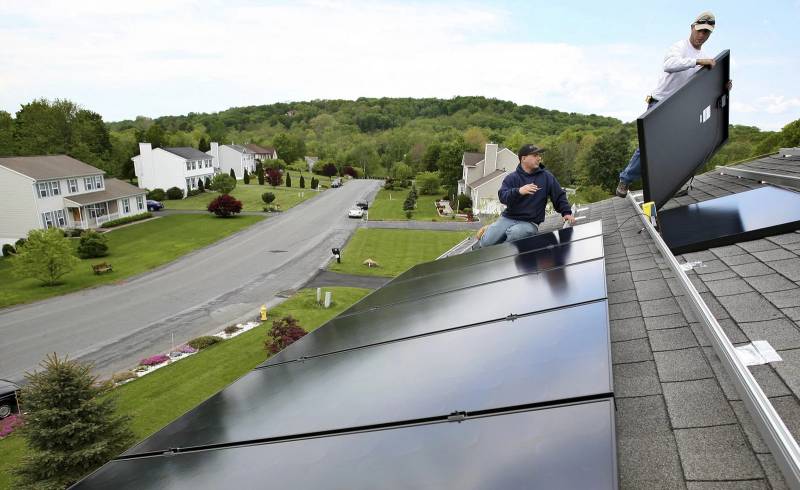The Act would also create a second rebate program, which would pay households between $2,000 and $8,000 for undertaking holistic upgrades such as new insulation or air sealing, which significantly lower their energy waste.
Money for residential solar panels and energy storage
For homeowners looking to capture renewable energy themselves, the Act would bulk up existing tax credits for residential solar and as well home energy storage systems, basically giant batteries.
Taken together, these measures would reduce a building's draw on the electric grid during peak use, for example, when everyone is running their air conditioners during a heat wave.
"It really strengthens the grid for everybody," says Abigail Ross Hopper, president of the Solar Energy Industries Association.
Homeowners could get up to 30% of the cost of home solar back at tax time, retroactive to the beginning of 2022 and running through 2032, with the amount tapering until the end of 2034. The same incentive would apply to storage.
Electric vehicle tax credits aims to help low- and middle-income buyers, but excludes many vehicles
Experts say the bill's electric vehicle tax credits — up to $7,500 for a new EV and $4,000 for a used one — are a mixed bag.
Some measures would democratize who can buy an EV, according to John Helveston, an assistant professor at George Washington University who studies EV markets. Eligible buyers can't make more than $300,000/year on a jointly filed tax return when claiming the credit for a new EV, and the money cannot apply to a car that sells for more than $55,000, or truck/SUV/van priced higher than $80,000, a step that excludes luxury vehicles from the tax credit scheme.
"It's steering everything towards making more affordable, more accessible EVs for the mass market. And that's the direction we need to be going," says Helveston.
The credits could also be transferred to car dealers, in order to apply at the time of sale.
But half of the tax credit amount is tied to gradually increasing requirements that critical minerals used to make EV batteries come from North America or the U.S.'s free trade partners, something manufacturers say is difficult if not impossible right now.
"While we work to unlock supplies of critical minerals and ramp up battery production at home, we can't currently meet the demand for these materials on our own," wrote John Bozzella, president and CEO of the Alliance for Automotive Innovation, in a statement on the Act.
His group estimated that the language in the bill would exclude many models from qualifying, and that none could qualify for the full $7,500 once the mineral requirements kick in.
However, consumers should not despair, says Helveston, since the other half of the tax credit should be accessible for at least some vehicles.
"It's not all or nothing," he says.
Copyright 2022 NPR. To see more, visit https://www.npr.org.
9(MDAxOTAwOTE4MDEyMTkxMDAzNjczZDljZA004))

9(MDAxOTAwOTE4MDEyMTkxMDAzNjczZDljZA004))